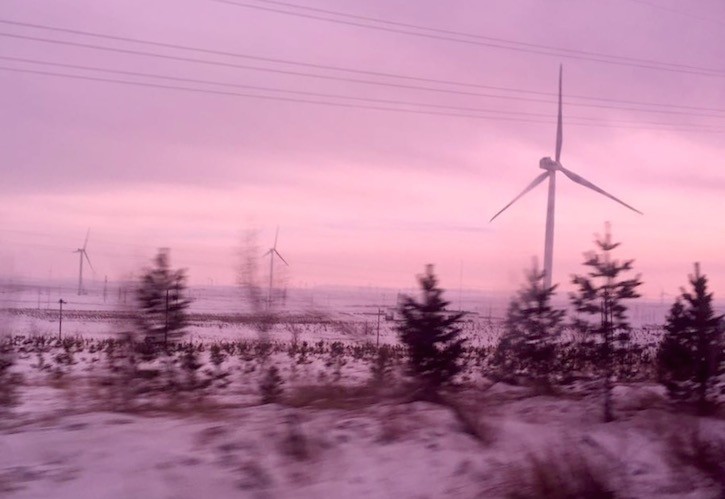By Anders Hove

The recent Paris climate change conference ended with a strong global framework and encouraging national commitments to reduce carbon emissions. But the big question remaining is how to implement those commitments on the ground. One of the most important issues facing cities, regions, and nations is how to transition from traditional high-carbon energy sources like coal to low- or zero-carbon sources like wind and solar power. Scaling up these new sources, and in particular integrating renewable power onto existing power grids, is a question being studied and modeled in almost every country. The problem is that most countries simply don’t have the right energy grids or policy models required to integrate significant new supplies of renewable energy.
Our team recently visited China’s Zhangjiakou, a city in the highly industrialized (and polluted) Hebei province that serves as a window into some of the major challenges of integrating renewable energy on the ground in China. Zhangjiakou will host the 2022 Winter Olympics, and so the city is already in the national spotlight. Named by China’s National Development and Reform Commission (NDRC) as a demonstration site for renewable energy, the city has committed to providing an astonishing 80 percent of its electricity from renewable sources—mainly wind and solar—by 2030. That target would surpass anything California or Germany currently has in the works in terms of percentage or absolute capacity.
Zhangjiakou already has substantial renewable energy capacity, and wind turbines are visible from almost everywhere along the expressway from Beijing to Zhangjiakou. But not all this electricity can be consumed locally in Zhangjiakou, a relatively small city. Furthermore, the city only has transmission capacity of around 5.5 GW, far below its combined wind and solar energy capacity of over 8 GW. Like other cities and regions in China that face similar transmission bottlenecks, one way Zhangjiakou is trying to not let its renewables go to waste is by focusing on creating demand: attracting electronic data centers, hydrogen production, and other electricity-consuming industries that need its new renewable power.
But Zhangjiakou is not an island, and there’s no reason its power policies should treat it like one. The city sits in the middle of the huge Beijing-Tianjin-Hebei (otherwise known as “Jing-Jin-Ji”) region, which has been targeted by Beijing to demonstrate how regional planning can address China’s economic and environmental challenges. And so while Zhangjiakou’s efforts to create new demand for power will help that city, creating jobs for local industry and tax revenue for local government, they won’t do much to advance the broader goal of regional energy transition. Without a push by regional and central government officials to address reform of the power sector—by providing regional incentives for purchasing and integrating renewable energy, for example—inefficiency and waste will continue.
Moving from city to regional renewable energy planning will require that regional leaders, including but not limited to those in Zhangjiakou, answer the question of how to move locally-produced power to a geographically dispersed set of regional energy users. The issue of how to get renewable energy from places with surplus supply to places that can use it is not unique to Zhangjiakou; in fact it’s one that many governments and companies all over the world are working to solve as we add more and more renewable energy to the grid globally.
One of the keys to better transmission is better transmission lines. The chairman of China’s State Grid, the country’s most powerful state-owned utility, Liu Zhenya, has outlined a vision, most recently shared last week at an energy conference in Houston, for a “global energy Internet” that would reduce fossil fuel emissions by enabling renewable energy from all over the world to be shared through a massive global ultra-high voltage electricity grid. It’s an ambitious and forward-thinking initiative, and represents a vision of what the grid of the future could look like.
But there are also important issues involving how those high-voltage lines are used, and what type of power grid operators prioritize when meeting regional energy demand. Germany and Texas provide good models for this kind of renewable energy integration onto the grid, as both places have already succeeded in bringing large amounts of wind and solar power onto their power grids with very low rates of waste. In 2009 Texas—which is functionally separate from the rest of the U.S. power grid, and hence especially challenging for renewable energy generators—suffered from more than 17 percent energy wastage, or curtailment. Today, thanks to new transmission lines planned specially to improve wind integration, less than 0.5% is wasted.
In China’s Jing-Jin-Ji and other regions, the solution may be less technical and more financial. Specifically, China’s central government may want to provide clearer and more consistent economic incentives for local officials and grid company planners to prioritize renewable sources when bringing power into existing grid operations. The good news is that promoting trade in renewable energy across provinces and within provinces is a stated goal of recently announced national power reform measures. But due to misguided tax incentives and grid barriers, local officials are still looking mainly at purely local, short-term solutions. That may be one reason that wastage of renewable energy in China is getting worse, not better—reaching 15% in 2015 at the national level, up from single-digits in 2014.
The answer in China will require both national policies that will incentivize the power sector to integrate renewable energy into its systems and efforts by local governments like Zhangjiakou to move away from coal-based energy. There are of course many vested interests—including officials who have gotten rich under the old, tightly controlled power system. But as China’s manufacturing sector slows, it is in a position to make the transition and show the world that integrating renewables can help the planet contribute to economic growth. Ultimately, this will be a test of Beijing’s political will.
Anders Hove is Associate Director of Research at the Paulson Institute.




